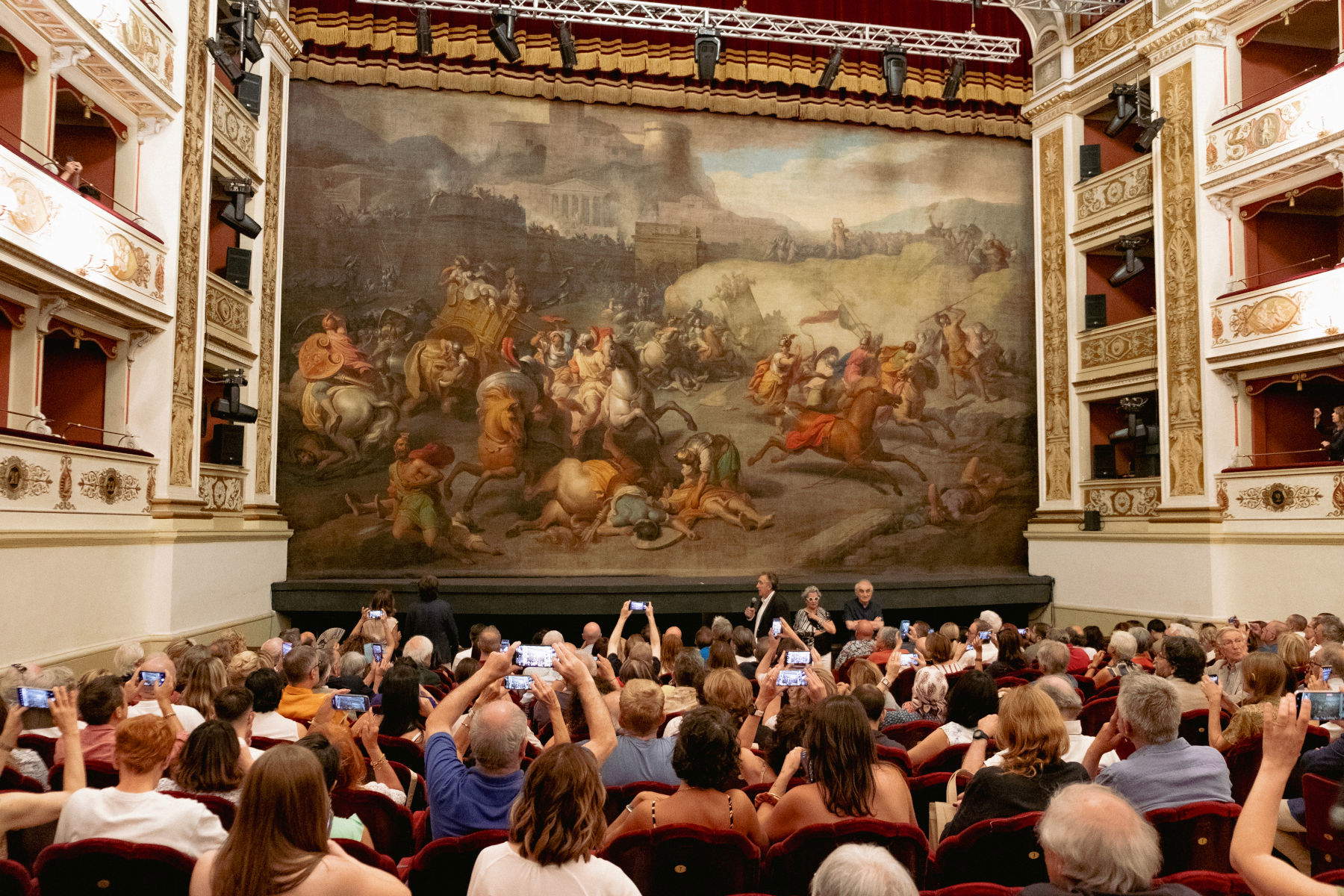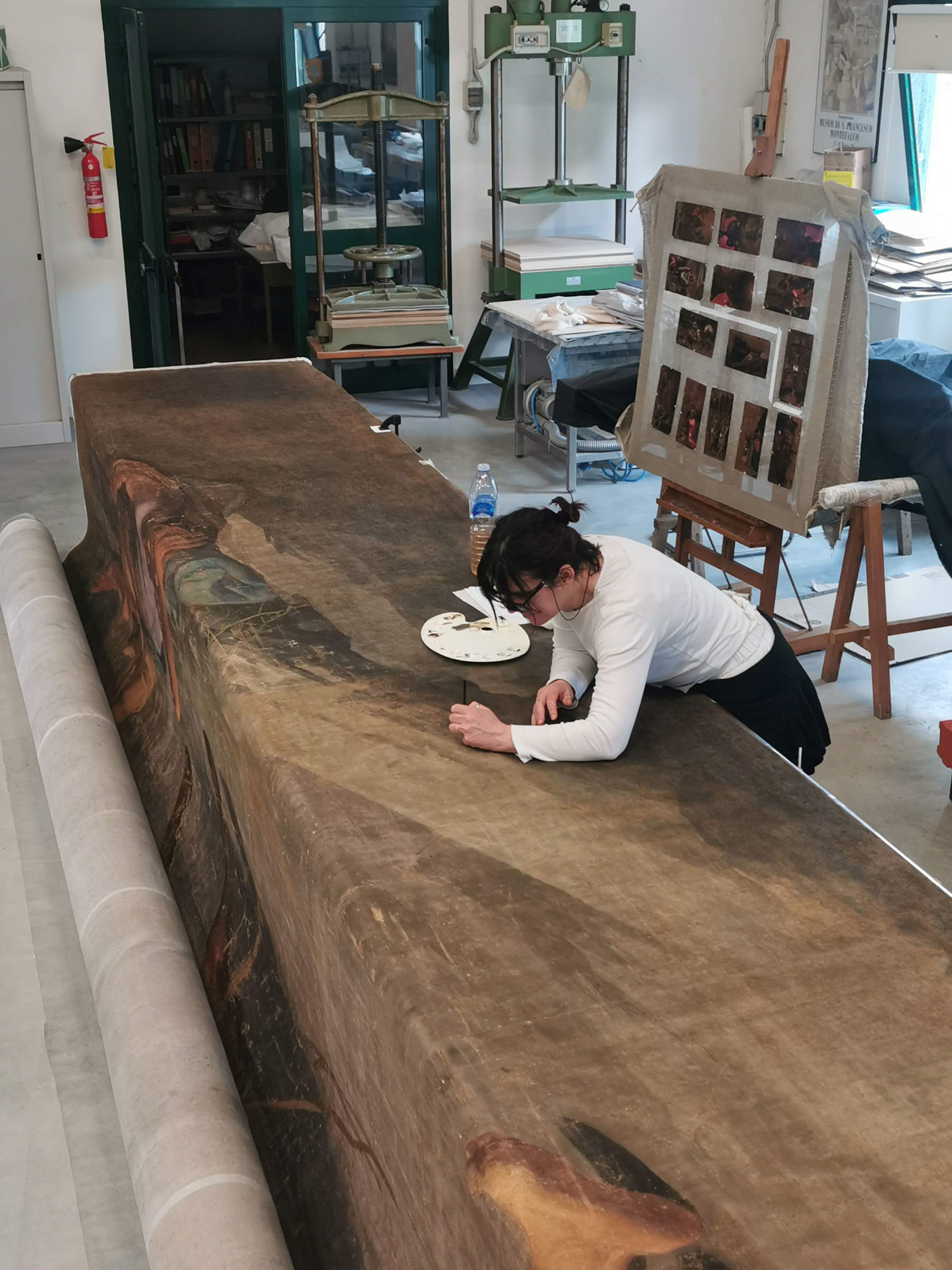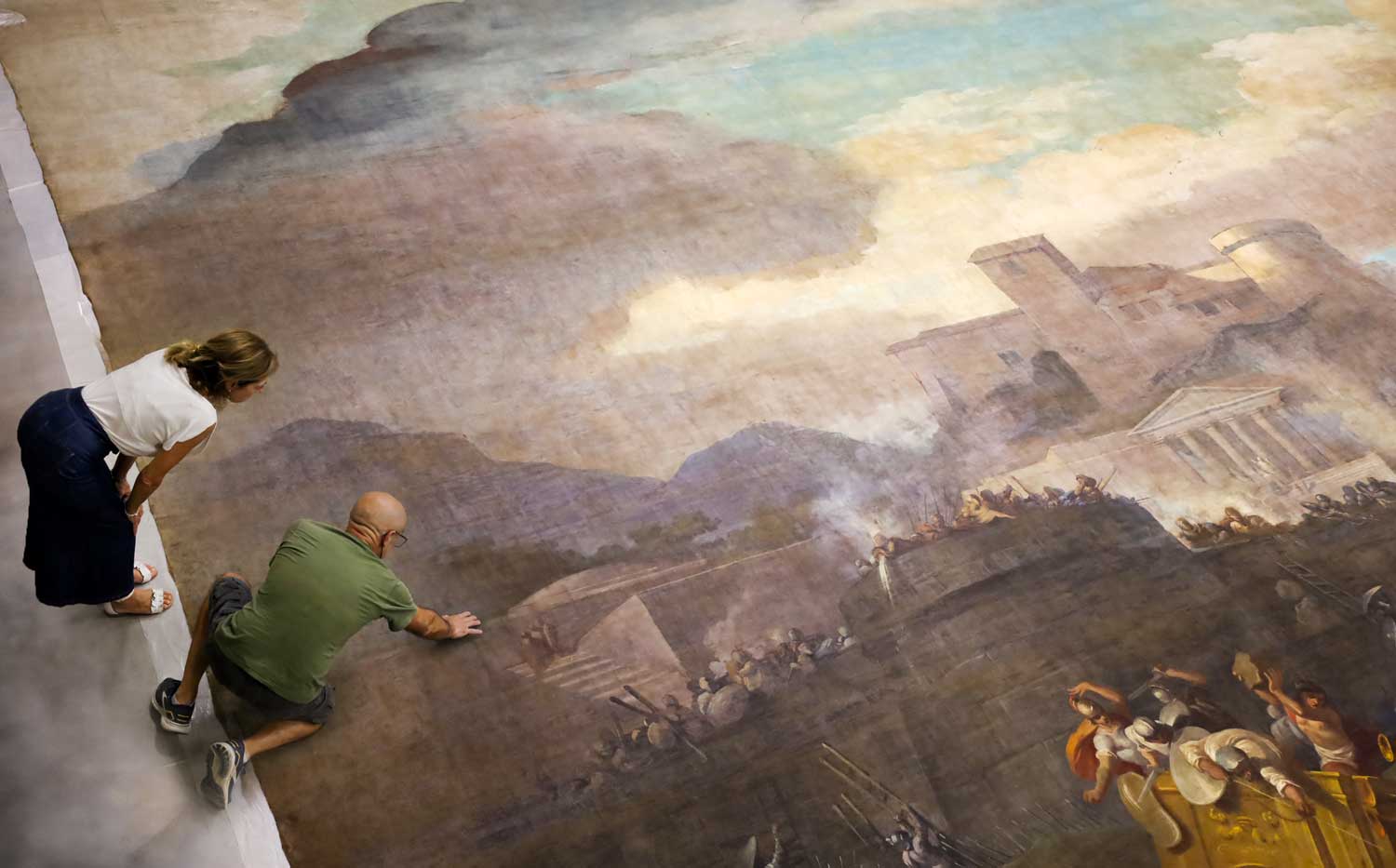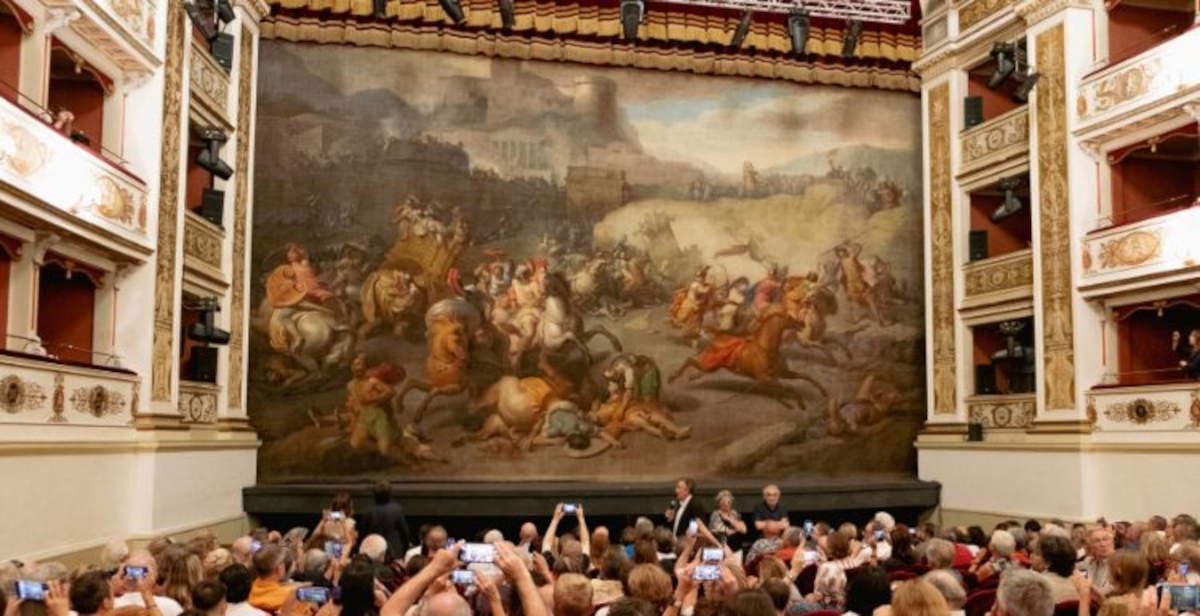The historic curtain of Spoleto’s Teatro Nuovo Gian Carlo Menotti, created in 1860 by painter Francesco Coghetti (Bergamo, 1802 - Rome, 1875), has returned to public view after a quarter of a century. The work, which had been removed and kept in storage for conservation reasons, was restored and officially presented during a meeting held last Saturday in the same theater, in the presence of institutions and project technicians. The public presentation was attended by the mayor of Spoleto, Andrea Sisti; Filippo Settimi, managing director of AgriEuro srl, a company that financed part of the restoration through theArt Bonus; art historian Stefania Petrillo, professor at the University of Perugia and author of the monograph Sipari d’Italia; Antonella Filiani, president of the restoration cooperative Coo.Be.C., and architect Moreno Orazi of Studio Abaco.
The restoration cost a total of about 210,000 euros. Of these, 130,000 were donated by AgriEuro through the Art Bonus tax tool, while about 80,000 were co-financed by the City of Spoleto. Precisely because of the mechanism, which allows individuals and businesses to financially support cultural heritage by receiving tax benefits in return, the intervention was able to materialize. The project was also selected as the winner of the Art Bonus 2025 Competition, promoted by the Ministry of Culture in the category of Cultural Heritage and Places.
“Presenting to the public the Historic Curtain, restored and permanently relocated to the Teatro Nuovo Gian Carlo Menotti, on the occasion of the Festival of Two Worlds is a moment of extraordinary importance for the City, for its history, and for the artistic value of this majestic work,” said Mayor Andrea Sisti. “The fact that all this is the result of a particularly effective collaboration between private parties and public institutions, the result of a choral commitment both economically and operationally, restores the value of a path begun more than a year ago that has allowed the City to once again be able to admire a wonderful asset. I again thank Agrieuro, the Coo.Be.C, Studio Abaco, the Spoleto nel Cuore Association and all those who with their commitment and professionalism have made it possible to achieve this result.”

“We are proud to celebrate today the return of the Historic Curtain to the Teatro Nuovo Gian Carlo Menotti, after more than 25 years of absence,” commented Filippo Settimi, CEO of AgriEuro and co-financier of the Art Bonus initiative together with the City of Spoleto. “The restoration of this extraordinary work of art was a commitment that AgriEuro chose to support with passion, by virtue of the strong bond that has always united us to the city of Spoleto. We undertook this project under the banner of the social responsibility we feel for our territory: the goal was to return such a strongly identifying cultural symbol to the city and pass on its value to future generations. To see today the Curtain return to its original function, in such a unique context as the Festival of Two Worlds, is an indescribable emotion. We will be happy to continue working together with the City of Spoleto to create future initiatives that will allow all citizens to experience and approach this unique work.”
“The restoration of the Historic Curtain of Spoleto’s Teatro Nuovo, painted in 1861 by Francesco Coghetti of Bergamo, is an event of extraordinary importance not only for the quality and dimensions of the artifact, but also for its relocation in the theater, which allows it to regain its dual function, practical and symbolic,” commented Stefania Petrillo, Professor of Contemporary History at the University of Perugia and author of the monograph Sipari d’Italia. “The Curtain is the ”fourth wall“ of the room, the diaphragm separating the space of reality from that of fiction; in the crucial years of the Risorgimento, when it is ”historiated," it often becomes a true political manifesto. In Hannibal’s Escape under the Walls of Spoleto, the episode that recalls Spoleto’s victorious resistance to Hannibal’s siege in 217 B.C., the hope of an Italy that was finally free and united should thus be read in watermark. Municipal pride and participation in the project of national unity thus converge in the iconography of the spectacular “machine,” rich in pathos and dynamism, which engagingly recounts the civic epos while also assuming a high ethical and educational value."
The curtain, owned by the City of Spoleto, had been kept at the Coo.Be.C. restoration workshop for 25 years, awaiting a conservation intervention that would halt its progressive deterioration. In fact, the canvas (11.90 meters in height by 13.92 in width) had numerous structural problems: fabric deformations, seams and moisture damage. The conservation conditions required a complex intervention, carried out by a specialized team that faced the challenge of working on a pictorial work of great proportions, fragile and delicate by nature.

“The Coo.Be.C Cooperative Cultural Heritage since the 1990s had been holding the large curtain of the Teatro Nuovo in its restoration workshop,” explained Coo.Be.C. President Antonella Filiani. “Thanks to the synergies created between the public and private sectors in February 2024 was able to start its restoration. It started with the interventions of cleaning, consolidation of the constituent materials, recovery of deformations, repair of tears, cuts, lacerations and gaps and reinforcement of the unstructured textile support over an area of about 165 square meters. At the conclusion of the conservative restoration, operations of aesthetic re-presentation and those aimed at the re-functionalization of the curtain were continued. The restoration saw the involvement of most of the restorers from Coo.Be.C, each for their own expertise and all with the passion and enthusiasm of being able to return the work to the community after so long.”
“The New Theater has undergone substantial transformations over time. For example, where today there are dressing rooms and offices in the beginning was located a restaurant and rooms for the artists, and the orchestra pit itself did not appear in Aleandri’s project: the musicians occupied part of the stalls,” argued architect Moreno Orazi of Studio Abaco. “So if the theater has undergone from its construction to the present day significant transformations nevertheless strong over the years has been the action of protection aimed at preserving some peculiarities of its architecture. Among them undoubtedly the restoration of the Historic Curtain, thanks to the intervention splendidly carried out by the COOBEC company, which finally returns from today to perform the function of a wonderful scenic backdrop of the stalls, visible before the beginning and during the intervals of a performance. Special thanks to those who made possible the reassembly of the Historic Curtain in the Theater, a technical operation that was by no means simple.”

Made by Francesco Coghetti, a Bergamo artist active in the 19th century and known for his production of frescoes and large compositions with historical subjects, the curtain depicts the scene of Hannibal’s alleged defeat at the gates of the Umbrian city. According to legend, the people of Spoleto, in an attempt to repel the assault of the Carthaginians, allegedly poured boiling oil on the attackers from a semicircular fortification. The episode is told on the canvas with a graphic layout on two horizontal levels: in the lower part the battle, in the upper part the urban architecture, among which stands out the bastion from which the defensive action starts. Stylistically, the work shows a strong sense of movement, achieved through the use of bright contrasting colors, which increase the drama of the scene. The dynamism of the composition and the theatricality of the episode depicted make the curtain a demonstration of the visual culture and historical narrative of 19th-century Italy.
After the presentation, the restored curtain will remain on public view at scheduled events at the Teatro Nuovo. Its presence on the stage will become an integral part of the theatrical experience, enriching the scenic context with a visual reference to the city’s collective memory.
 |
| Spoleto, Teatro Nuovo's historic curtain returns: restored after 25 years thanks to Art Bonus |
Warning: the translation into English of the original Italian article was created using automatic tools. We undertake to review all articles, but we do not guarantee the total absence of inaccuracies in the translation due to the program. You can find the original by clicking on the ITA button. If you find any mistake,please contact us.